How To Cook Basmati Rice
For us Indians, nothing can be more comforting than a bowl of rice-dal. Even the fanciest of dishes can never take its place. When we do want to go a bit overboard, there’s the flavorful biryani, again made of rice. And when speaking of rice, it is almost a crime if I don’t mention about the long, fragrant basmati rice. This basmati rice recipe is a checklist to give you an insight on how to cook it (in a pot or pan) perfectly. I also share How to Cook Basmati Rice for Biryani with plenty of tips.
Basmati Rice – Pride of India
Scented, fine, non-glutinous and smooth – these are some of the ways to describe one of India’s most prized possessions, the basmati rice. Also, an Indian gift to the global connoisseurs and food cultures.
Basmati is formed of the Hindi words ‘bas’ meaning ‘fragrance’ and the suffix ‘mati.’ The tropical climate of India and soils nurtured by the snow fed rivers from the Himalayan region is suitable for the cultivation of this rice.
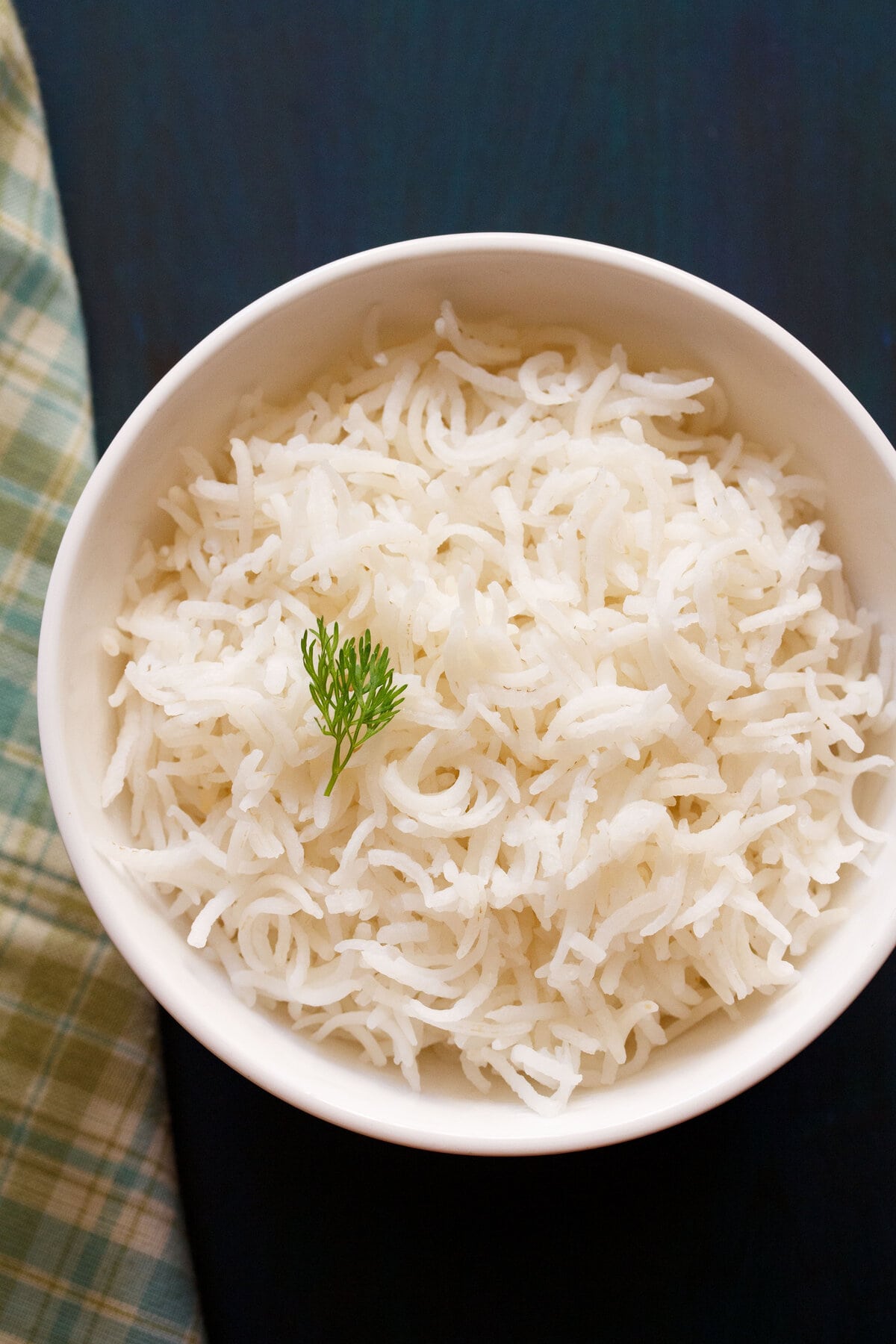
Thus, it is believed that Indian farmers from the northern regions have been growing this aromatic rice since ages now. In addition to the others, the slender shape of the basmati rice is also one of its important characteristics, portraying highly of the immemorial civilization that has nurtured it.
Areas where it is cultivated: Himachal Pradesh, Jammu & Kashmir, Uttarakhand, Haryana, Punjab, Delhi, western Uttar Pradesh
It is obvious that the basmati rice has been a royal favorite of many emperors and has had poets flattered by its character since centuries.
Cooking Basmati Rice
I decided to dedicate an entire post on how to cook basmati rice without any hassles, since the time it had been requested by many of my readers.
As rice is a regular feature in my home meals, I have to prepare it almost every day. This has also helped me to get a good experience in cooking this unique rice effectively, in a pan, pressure cooker as well as electric cooker.
Personally, I like the basmati rice recipe which gets done in a pan on stovetop, as it keeps the rice grains separate. So, on days when I have a meal consisting of a dal tadka, dal fry, vegetable/paneer or any other rich curry, I cook the basmati rice this way.
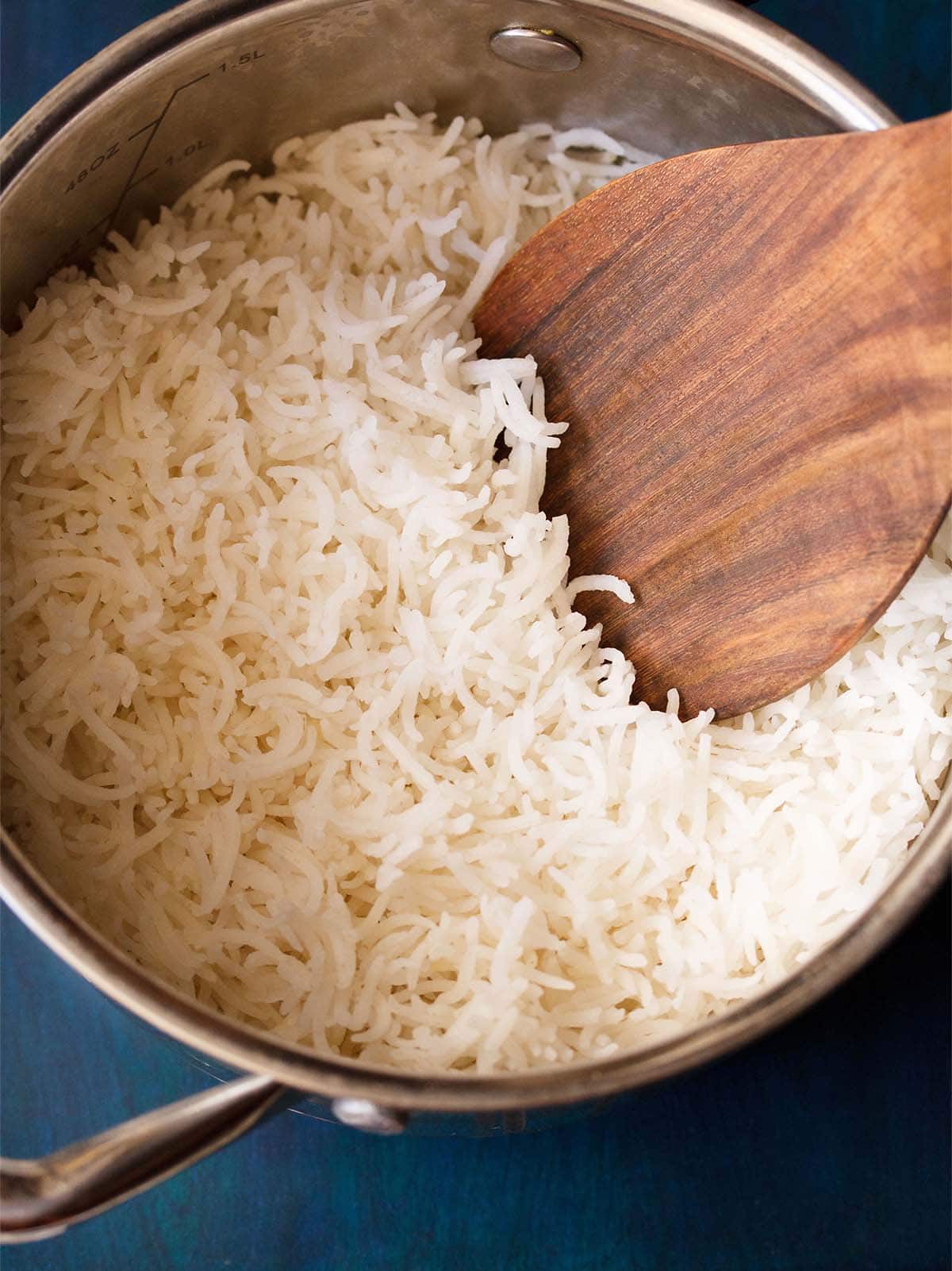
However, it is time consuming to cook this rice in a pan if I’m having relatives or guests coming over. On such days, I cook it in either a pressure cooker or electric cooker to fasten the process and reduce my workload.
The flipside of the basmati rice recipe cooked in these two equipment is that, the rice grains are sticky and may not be preferred by some. I mean just imagine mixing a lovely lentil curry with sticky, mushy rice. It would result in thick, unappetizing blobs of rice-dal morsels!
Methods of Cooking
Technically, there are two ways in which you can cook this rice. This is essentially for the times when you are using a pot to cook the rice.
- Boiling method – Rinse the rice grains, place in sufficient amount of water in a pot and put it on a stovetop. You can discard the water once the rice if cooked.
- Absorption method – In this, rice is cooked in a precise amount of water.
I tend to use both the methods, as and how required. However, this post focuses on using the absorption method of cooking this rice.
In this, the rice grains are getting cooked till they turn soft and fluffy. The basmati rice is not ‘al dente,’ meaning the rice grains don’t have a slight bite to them. This is important to note as even a little uncooked bite in the rice can give you stomach issues.
Rice and Water Ratios
Generally, the ratio of rice to water for basmati rice or any other regular rice is 1:2, which is what even I follow while cooking it in a pot. This will change when using brown basmati rice or parboiled basmati rice (sella basmati rice) as the cooking time for both these is more than their counterparts.
Following are some of the rice to water ratios for cooking pre-soaked rice in a pot:
- 1:1.75 to 2 for regular basmati rice
- 1:2 to 2½ for organic basmati rice
- 1:2½ to 3 for parboiled basmati rice
- 1:3 for brown basmati rice
Tips & Tricks
1. Quality and Age: While preparing biryani or your simple everyday basmati rice, one of the most important factor is to use a good quality basmati rice. if you are able to use the right one, half the job is done.
You can always first try cooking the rice plain and see if the grains get cooked fluffy and separate. Try to use a good quality and aged basmati rice.
2. Rinsing: Rinse the basmati rice really well until most of the extra starch is washed off. This does help in giving non-sticky and fluffy rice grains after being cooked.
3. Proportion of Water: Experiment a few times. I have used various brands of organic basmati rice as well as Indian brands of basmati rice. At times some of them yielded sticky mushy rice, even after rinsing them very well in water as well as cooking for the right period of time and using less water.
After cooking the rice for a few times, you will know how much water is needed to get them perfectly cooked. Most presoaked basmati rice will need about 1.75 to 2 cups of water.
Organic basmati rice needs more water to cook than the regular variety of basmati rice. Aged and parboiled basmati rice will also need more water.
4: Using Fat: Adding a bit of fats like oil, butter or ghee helps to make the rice grains non-sticky and separate.
How to cook Basmati Rice – In a Pan
Rinse and Soak Rice
1. Take 1 cup heaped basmati rice (200 grams) in a bowl.
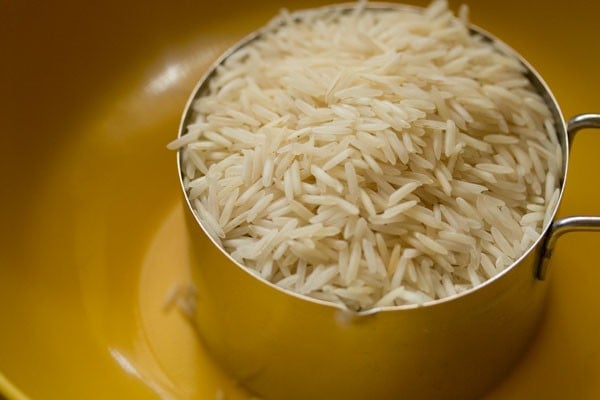
2. Begin to rinse the rice grains in running water. Rinse the rice with a gentle swirling of your fingers in the bowl.
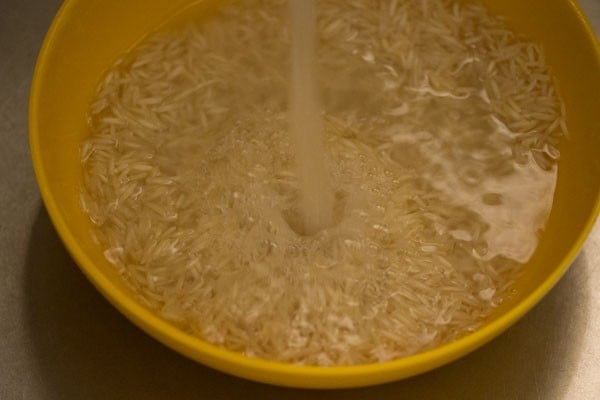
3. You can see opaque water in the below picture. That’s the starch in the water.
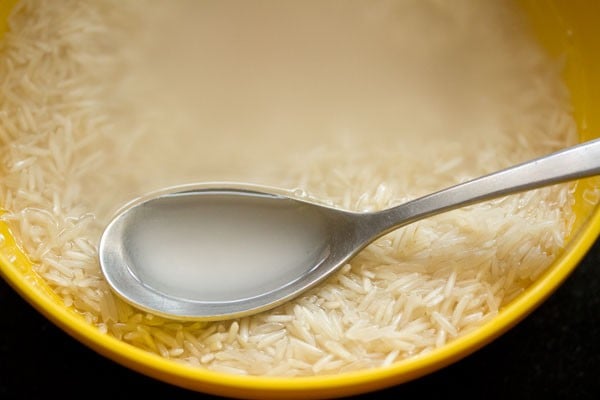
4. The rice has to be rinsed till the water becomes clear, transparent and without starch.
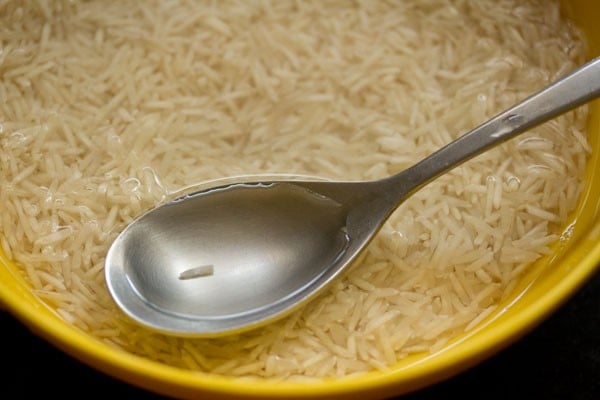
5. Then, soak the rice in ¾ to 1 cup water for 30 minutes. If using more quantities of rice, add more water.
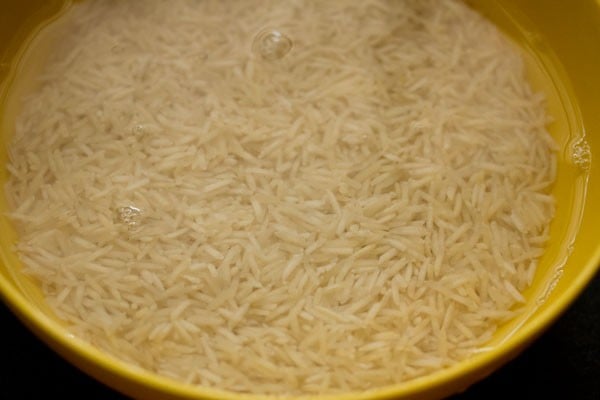
6. After 30 minutes, strain the rice well using a strainer. Drain all the water and set aside.
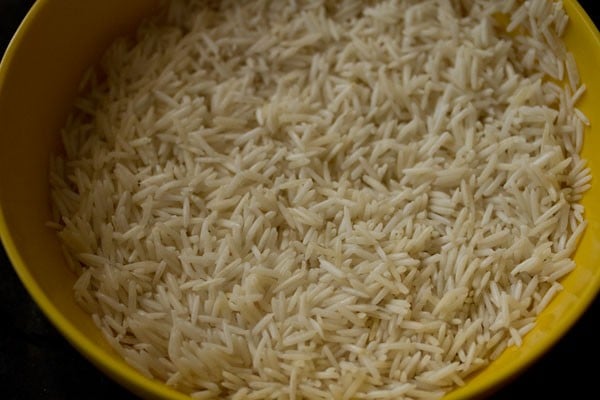
Cook Basmati Rice
7. In a deep thick bottomed pan, add 2 cups water. Use a wide deep pan so that the water doesn’t spill out while cooking.
Tip: The amount of water to be used depends on the quality of rice. Sometimes some basmati rice grains cook quickly in less water. In this case, you can add 1.75 cups water.
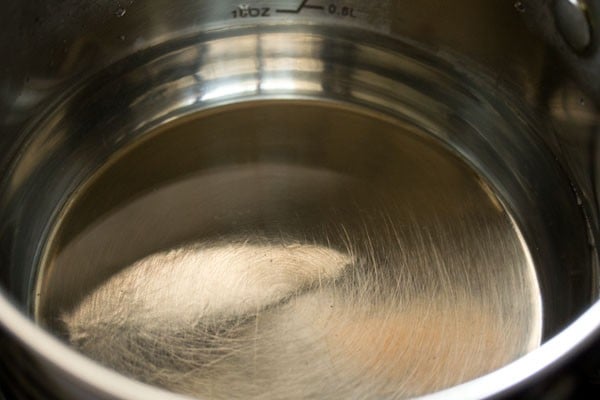
8. Add ½ teaspoon oil. You can also use butter or ghee. This step is optional and you can skip it too.
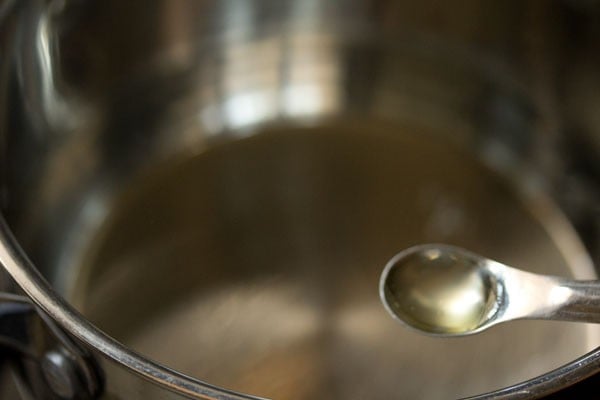
9. Add ¼ teaspoon salt or as per your taste. Sometimes, even I don’t add salt.
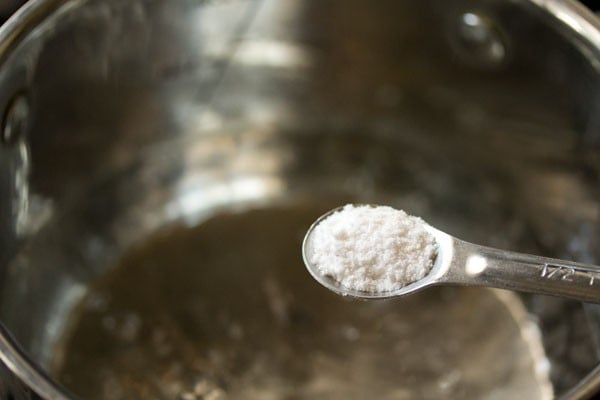
10. On medium heat, let the water come to a boil.
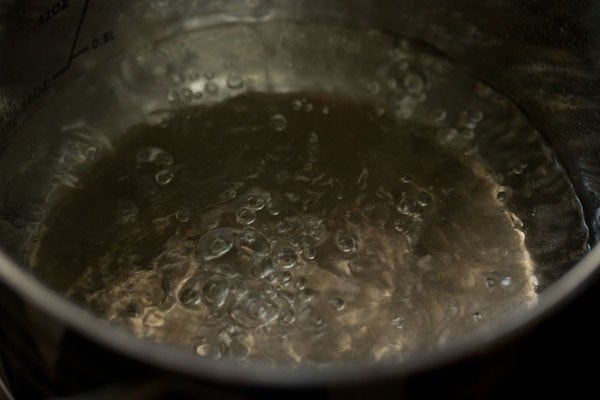
11. Add the drained rice.
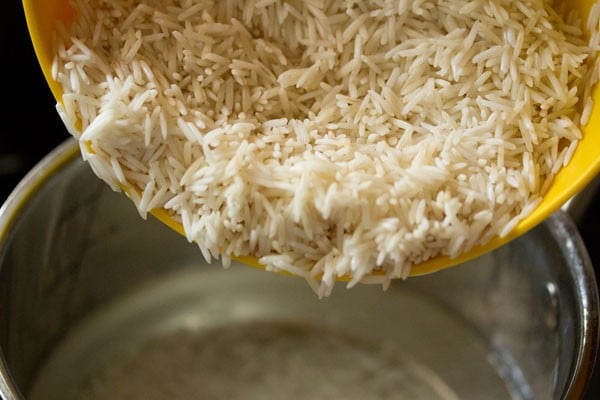
12. Once all the rice is added, you can gently shake the pan, so that the rice grains settle down.
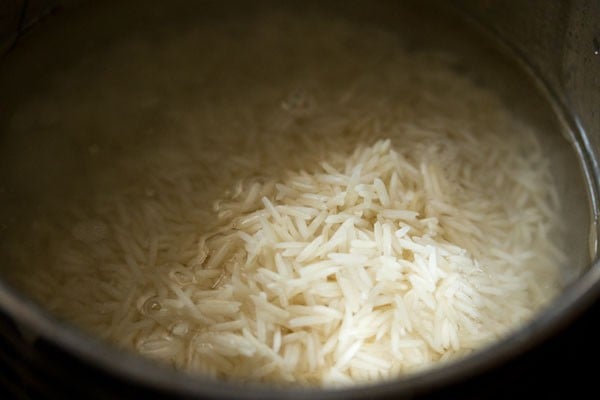
13. Or alternatively, you can also give a gentle stir with a fork.
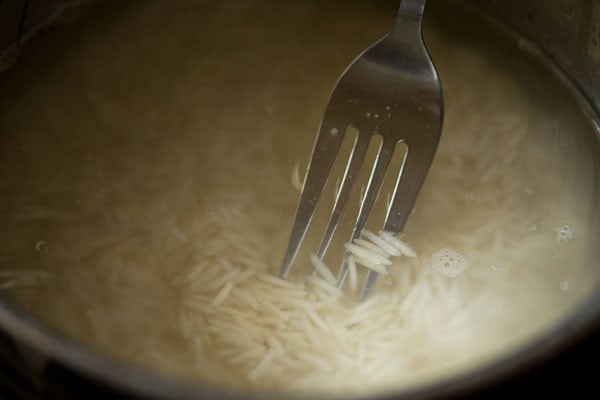
14. Cover the pan with its lid. You can check once or twice while the rice is cooking. If the grains do not look cooked and the water is over, add 2 to 3 tablepoons hot water. Stir gently with a fork.
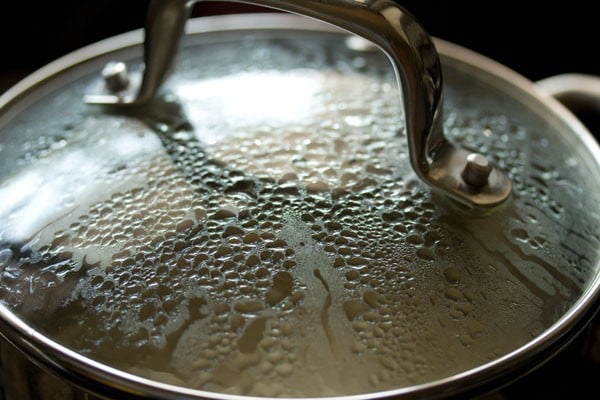
15. Lower the heat and cook the rice till all the water has been absorbed and the rice grains have cooked well. It took 8 minutes for the rice to be tender, soft and fluffy. This time will vary with the type, quality of pan and the intensity of heat.
Check Doneness
Press a cooked rice grain with your thumb and forefinger. It should be soft and mash easily.
Or bite into a few rice grains. It there is resistance in the bite, this means the grains need to be cooked for some more time.
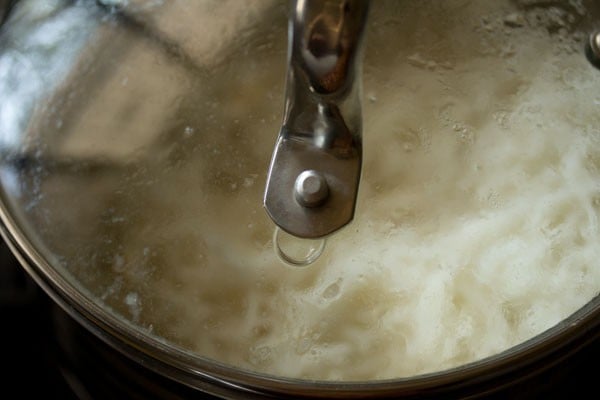
16. Once the rice grains are cooked, allow a resting time of 5 minutes, before you open the lid. Then, gently fluff the rice with a fork.
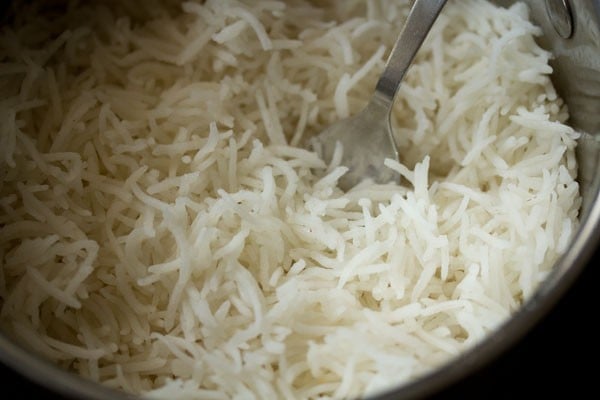
17. Serve perfectly cooked basmati rice with your favorite curry like kadai mushroom, paneer butter masala, palak paneer or dal.
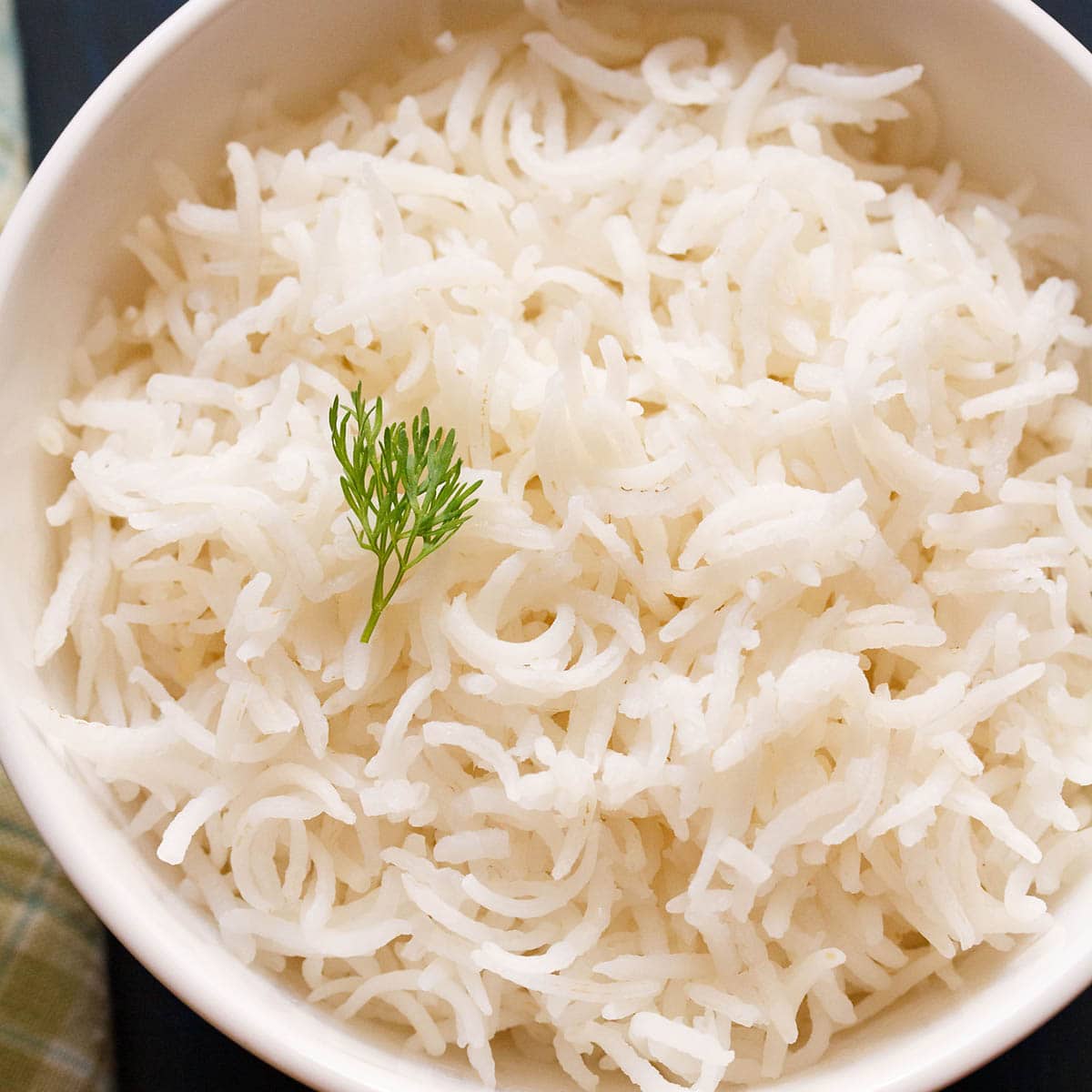
Cooking Basmati Rice for Biryani
Making Basmati Rice for a layered biryani is not a rocket science. With plenty of tips and tricks I also share here to make perfect basmati rice for a dum cooked and layered Vegetable Biryani Recipe. It is going to help you cook a really good, full and flavorful biryani.
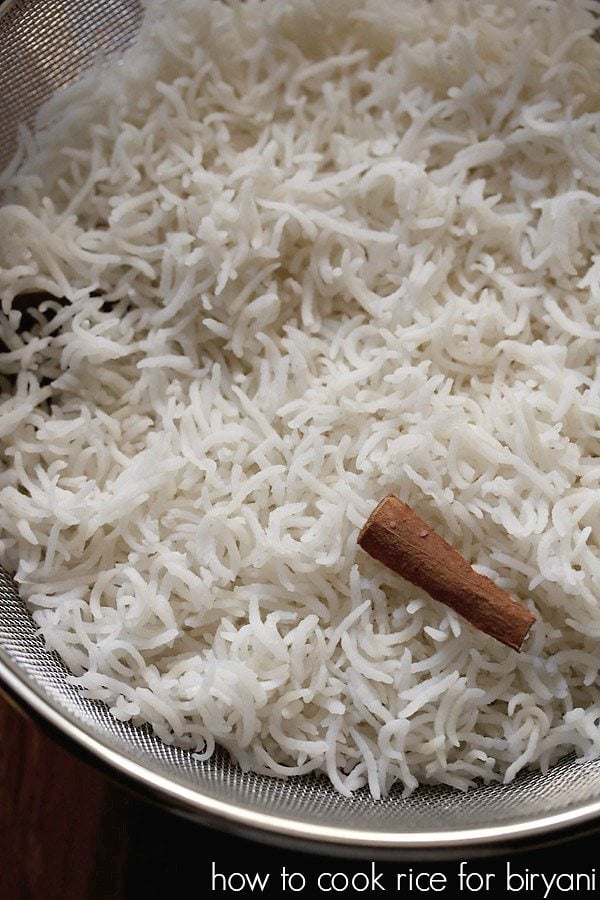
For the traditional dum cooked layered biryani varieties, the rice grains are par-cooked or half-cooked. Meaning they are not cooked completely.
The method of cooking basmati rice for biryani shared here is only meant for making biryani recipes in which the rice grains are 75% cooked. Rice grains that are ¾ᵗʰ or 75% cooked can be used in making vegetable biryani, paneer biryani and mushroom biryani.
When making a biryani recipe always follow the recipe. Some biryani recipes where less gravy or yakhni is used, the rice grains can be cooked till 90%. For some recipes you may need to cook the rice grains till they are 50% or 60% cooked.
With any biryani recipe, the cooking time of the rice will depend on the particular recipe as every recipe will be unique. In many of the vegetarian biryani recipes that I have shared here, I have par-cooked the rice grains till 75%.
Sometimes I do get comments or queries where readers have not been able to have a separate and yet fully cooked grains of rice in a traditional biryani. The rice becomes too mushy and soft.
Why is my rice mushy
While making any biryani, if the rice gets too mushy or soft, the texture, flavor and taste of the biryani does not come through very well.
Let me tell you why this happens. In a layered dum cooked biryani, the rice is cooked twice:
- First is the regular cooking of rice in water and
- Second is further cooking of the rice in a tightly sealed pot or pan.
So if the rice is just about cooked or cooked perfectly in the first instance, then while cooking for the second round, the rice gets overcooked and ends up making a mushy or pasty biryani.
Hence when making a biryani, par-cook the rice till its ¾ᵗʰ or 75% done. Also, if there are too much liquids in the gravy base, it will end up making the rice overcooked.
Now you will ask, how to find if the rice is cooked ¾ᵗʰ . You need to check the doneness of the rice grains. I have explained the method in the step-by-step photos below.
The most common method use to cook rice while making biryani is the rapid boiling method.
- In this method the rice is cooked in ample amount of boiling water.
- Once the rice grains are cooked, the water is discarded.
- Hence any remaining amount of starch that is there in the rice also gets discarded with the water. Thus making the rice less sticky or with no stickiness.
Cooking rice for a biryani is not difficult at all. with some tips kept in mind, one can make perfectly cooked rice.
I make biryani occasionally during weekends and by now I make really good biryani. When I have biryani in restaurants, I feel the ones I make at home are better.
How to cook Rice for Biryani
1. Take 1.5 cups basmati rice (300 grams) in a bowl. You can use any amount of rice depending on the biryani recipe you are making.
But do the change the proportion of water that you will need for cooking depending on the amount of rice used. Eg. for 1 cup of basmati rice, you can take 3 to 3.5 cups water.
Rinse by gently mixing the water with the rice grains in a bowl. Rinse until you get water which is clear and not cloudy.
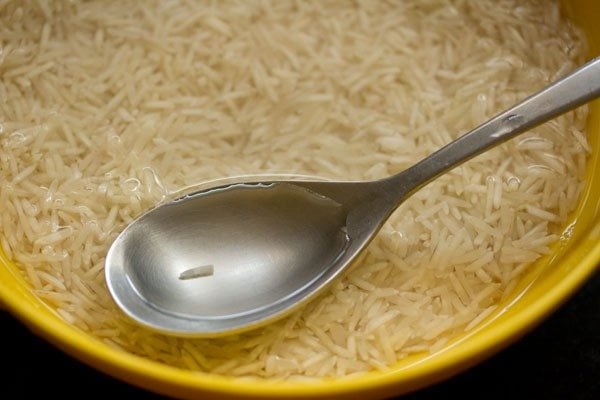
2. Soak the rice in 1 cup water for 30 minutes. Soaking is essential, so do not skip this step. If you are used parboiled rice (sella basmati rice) than soak for an hour.
After 30 minutes drain all the water and set the rice aside.
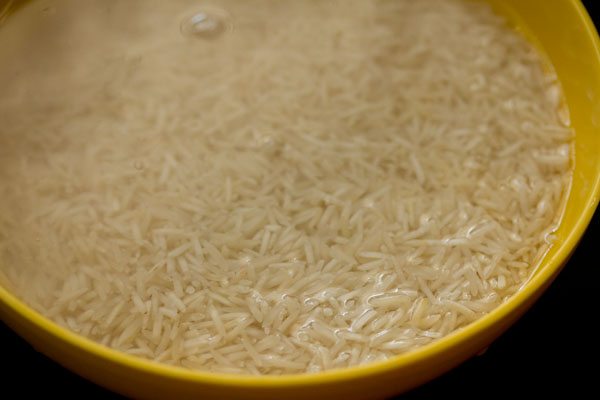
3. Take a deep bottomed pan. Add 5 cups water and heat the water on a high flame.
Tip: To save time, I heat the water first in an electric kettle. Then add the hot water to the pan and place the pan on the stove top.
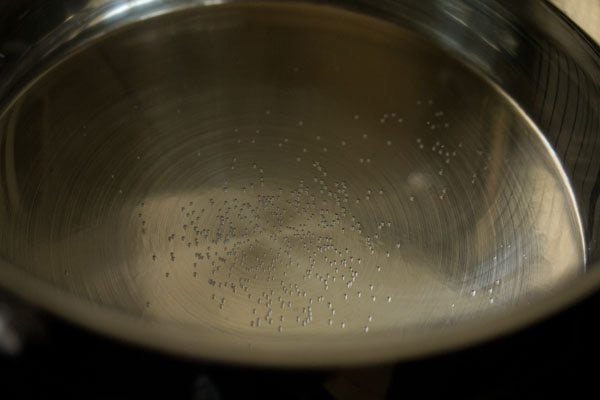
4. When the water becomes hot, add all the spices – 1 tej patta, 3 green cardamoms, 3 cloves, 1 black cardamom, 1 inch cinnamon. Also add ½ tsp salt or as per your taste.
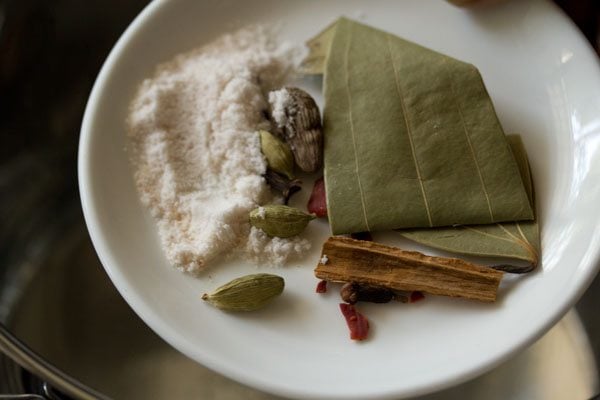
5. Usually for most biryani recipes, the rice is cooked together with the spices. But if you do not have spices or do not want to add any spices, then just skip them.
You can also add the spices mentioned in the recipe or your own choice of spices.
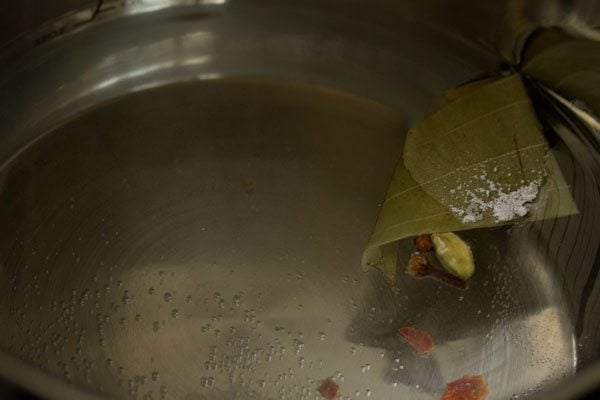
6. Bring the water to a rapid boil.
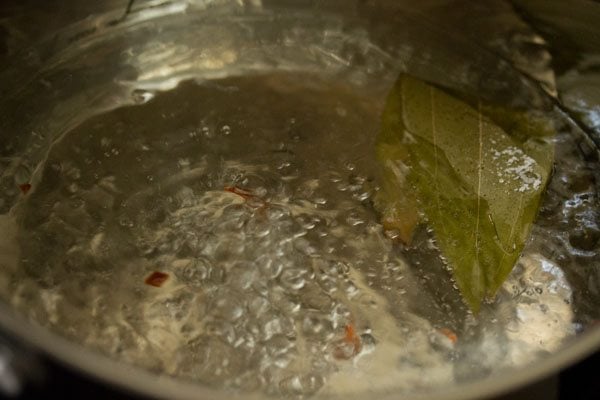
7. Then add the rice. You can also add ½ to 1 teaspoon of oil or ghee at this step. I generally do not add oil or ghee.
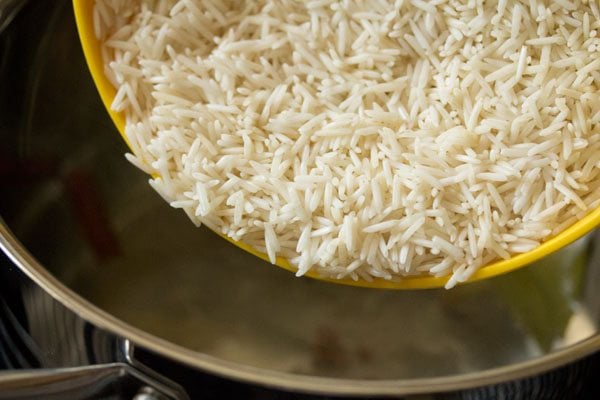
8. Just gently stir with a spoon or fork, after you add the rice.
Tip – one of the readers had given this suggestion to add a few drops of lemon juice. Addition of lemon juice, helps in making the rice grains longer, whiter and non-sticky.
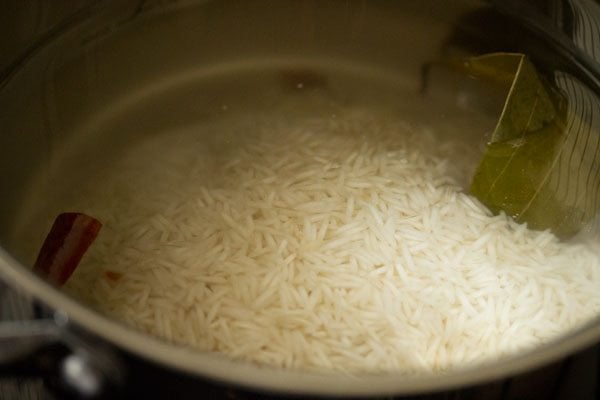
9. You will see that after adding rice, the temperature of the water decreases a bit.
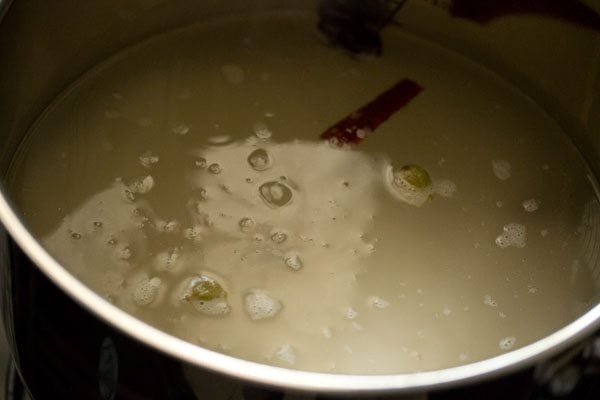
10. Do not reduce the flame and continue to cook the rice without any lid. It just takes about 10 to 12 minutes for the rice to be cooked.
Timing will vary with the intensity of the flame, the thickness and size of pan and the quality of rice grains. The water will reduce as the rice grains will absorb the water and swell.
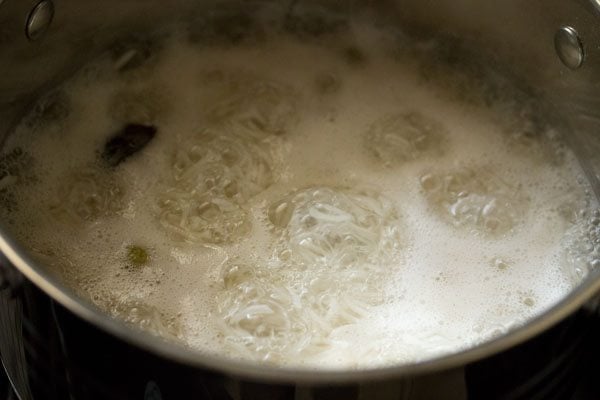
11. The rice has to be 75% or ¾ᵗʰ cooked. The grains should have a slight bite to them when cooked. The rice should not be fully cooked but almost cooked.
To Check
- You can either press the rice grains between the forefinger and thumb or bite a few rice grains. While pressing, the rice grains you should feel the softness of the cooked rice as well as a faint rawness in the rice. Meaning while you press the grains, it should get mashed but also there will be some denseness in them.
- If biting, you should get a slight bite in the rice grains.
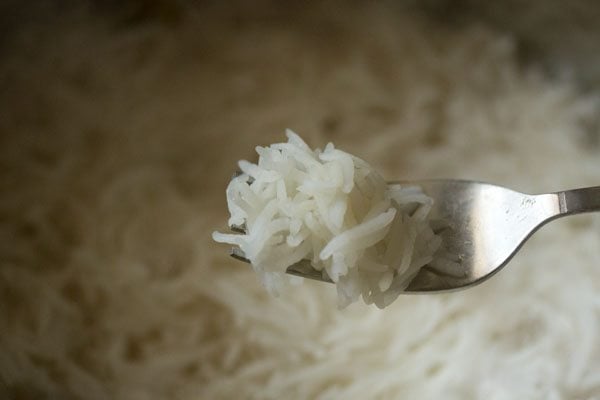
12. Remove the pan from the stove top and immediately drain the rice in a colander. You can also rinse the rice gently with water so that the grains stop cooking.
Gently fluff and keep aside. You can also spread the rice in a plate or tray. Spreading them in a plate helps them to cool faster and they are easy to handle when you begin the layering.
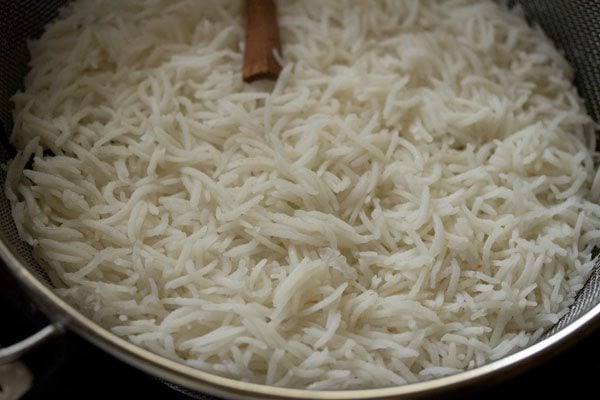
13. When the rice becomes warm or cools at room temperature, you can use it for layering in biryani. The below photo is of the Veg Biryani made with this cooked basmati rice.
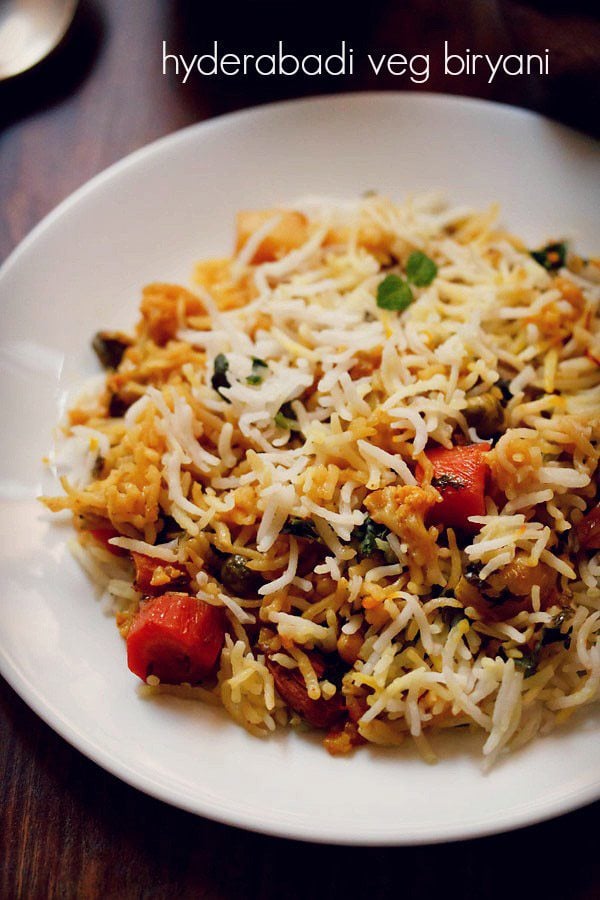
Step by Step Photo Guide Above
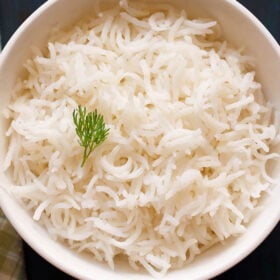
Ingredients
- 1 cup basmati rice (heaped) – 200 grams
- 2 cups water for cooking or add as required depending on the quality of rice
- ½ teaspoon oil – optional
- ¼ teaspoon salt or add as per taste
Instructions
Prepping and soaking basmati rice
- Take the basmati rice in a bowl.
- Begin to rinse the rice grains in running water. Rinse the rice with a gentle swirling of your fingers in the bowl.
- The rice has to be rinsed till the water becomes clear, transparent and without starch.
- Then soak the rice in ¾ to 1 cup water for 30 minutes.
- After 30 minutes, strain the rice very well of all the water and set aside.
Cooking basmati rice
- In a deep bottomed pan, add 2 cups water. Use a wide deep pan so that the water does not spill out while cooking.
- Add oil. You can also use butter or ghee. This step of adding oil is optional and you can just skip it too. Also add salt.
- On a medium heat, let the water come to a boil. Then add the rice.
- Once all the rice grains are added, you can gently shake the pan, so that the rice grains settle down. Or alternatively, you can also give a gentle stir with a fork.
- Cover the pan with its lid.
- Lower the heat and cook the rice till done and all the water has been absorbed. It took me 8 minutes for the rice to be tender, soft and fluffy. You can check once or twice while the rice is cooking.If the grains do not look cooked and the water has got over, then add 2 to 3 tablespoons of hot water. Stir gently with a fork without breaking the rice grains.
- To check the doneness, press a cooked rice grain with your thumb and forefinger. It should be soft and mash easily. Or you can eat a few rice grains. It there is resistance in the bite, this means the grains need to be cooked for some more time.
- Allow a standing time of 5 minutes, before you open the lid. Then gently fluff the rice with a fork.
- Serve these perfectly cooked rice grains with your favorite curry or gravy.
Notes
- While I have cooked 1 cup of raw basmati rice, feel free to reduce or increases the ingredients. Remember to proportionately increase the water quantity if you have increase the amount of rice.
- To make fragrant rice, add a few whole spices like 1 green cardamom, 1 inch cinnamon, 1 to 2 cloves, 1 tej patta and ½ teaspoon cumin seeds to the water while boiling.
- You can also cook the basmati rice in vegetable stock or broth to make it more flavorful.
Nutrition
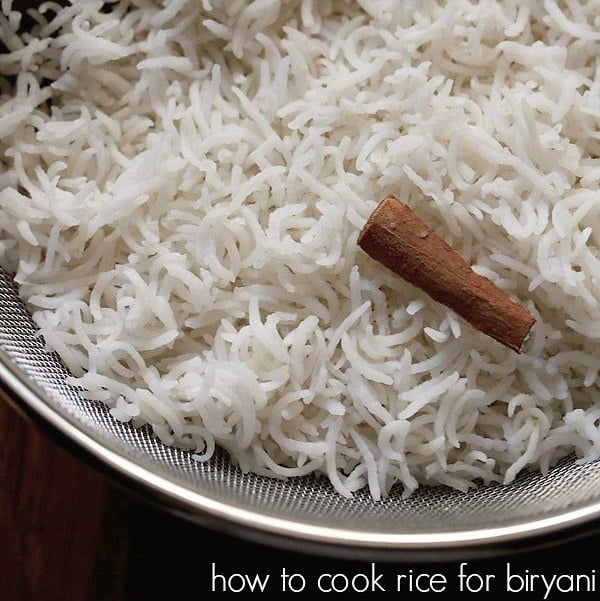
How to cook Rice for Biryani
Ingredients
Method
- In a bowl take the basmati rice. You can use any amount of rice depending on the biryani recipe you are making.
- Start to rinse the rice grains in running water. Rinse the rice grains with a gentle swirling of your fingers in the bowl.
- Rinse rice until the water looks clear, transparent and without starch.
- In the same bowl, soak the rinsed rice for 30 minutes.
- After 30 minutes drain all of the water from the rice using a strainer. Set the rice aside.
- Take a deep bottomed pan. Add 5 cups water and heat the water on a high heat. To save time, I heat the water in an electric heater. Then add the water to the pan and place it on the stove-top.
- When the water becomes hot, add all the spices and salt as required.
- Usually for most biryani recipes, the rice is cooked together with the spices. But if you do not have spices or do not want to add any spices, then just skip adding them.
- Bring the water to a rapid boil. Then add the rice. You can also add ½ to 1 teaspoon of oil or ghee at this step.
- Just gently stir with a spoon or fork, after you add the rice.
- Do not reduce the flame and continue to cook the rice without any lid.
- The rice has to be 75% or ¾ᵗʰ cooked. The grains should have a slight bite to them when cooked. The rice should not be fully cooked but almost cooked.
- Remove the pan from the stove top and immediately drain the rice in a colander. You can also rinse the rice gently with cool water so that the grains stop cooking. Gently fluff and keep aside.
- You can also remove and spread the rice on a large plate or tray. Cover with a lid.
- When the rice becomes warm or cools down, you can use it for layering in biryani.
Nutrition
Notes
- While my recipe shows you cooking 1.5 cups of basmati rice, feel free to change the quantities of the ingredients proportionately.
- You can skip the spices if you do not have them.
- Adding lemon juice is optional and can be omitted.
Tried this recipe?
Let us know how it was!This Basmati Rice recipe post from the archives first published in December 2015 has been republished and updated on 8 June 2022.

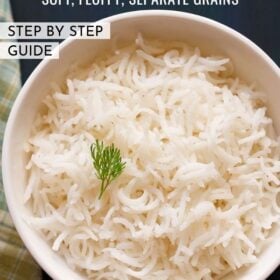
I really appreciate this recipe, it has helped me get a great result cooking basmati rice which is my favorite! thank you so much Dassana
Most welcome and thanks.
Dassana, I want you to know that you are doing a wonderful job!! Your knowledge of cooking must have helped millions of people and they would bless you each time they sit to eat their meals. I didn’t know any cooking as I had lost my mother and grandmother at a young age. And you came to my rescue.
kajal first of all a big hug to you. thank you for these words. i am emotional and teary-eyed. thanks again and i wish you all the best in your life.
Is it not possible to cook basmati rice in pressure cooker? Becoz everytime I cook it pressure cooker the rice turns out so mashy and sticky.
Thanks,
Uma
in pressure cooker, basmati rice does turn sticky. so i always end up cooking in a pan.
My remarks are not getting posted. Please help
megha, your comments goes to moderation before getting published. this is to sort out spam comments.
Thank you so much. Your website is very very interesting and lovely.
Thank you for being an inspiration for all the recipes.
Beautiful ways and beautiful explanation and awesome presentation. A very homely website.
Thank you Dassana for being there.
welcome megha. glad to know that you liked the website. thanks for sharing positive feedback.
when i soak the rice… the grains break..what do i do
the grains break after soaking the rice or while cooking them?
Should u rinse rice all the time before u cook it.
i always rinse rice before i cook them.
Thanks! Please share sweet pulao recipe.
have noted down the recipe request.
Hi,
I have been trying most of your recipes and everything come out perfect. I would like to know which brand of basmati rice do you use? Mine doesnt get this long after cooked.
thanks nitu. i have used here indian gate basmati rice classic brand.
It would be nice to have a share button for the website and different recipes. Thanks
you mean sharing of social media buttons? social media buttons are already there for the sharing of recipes.